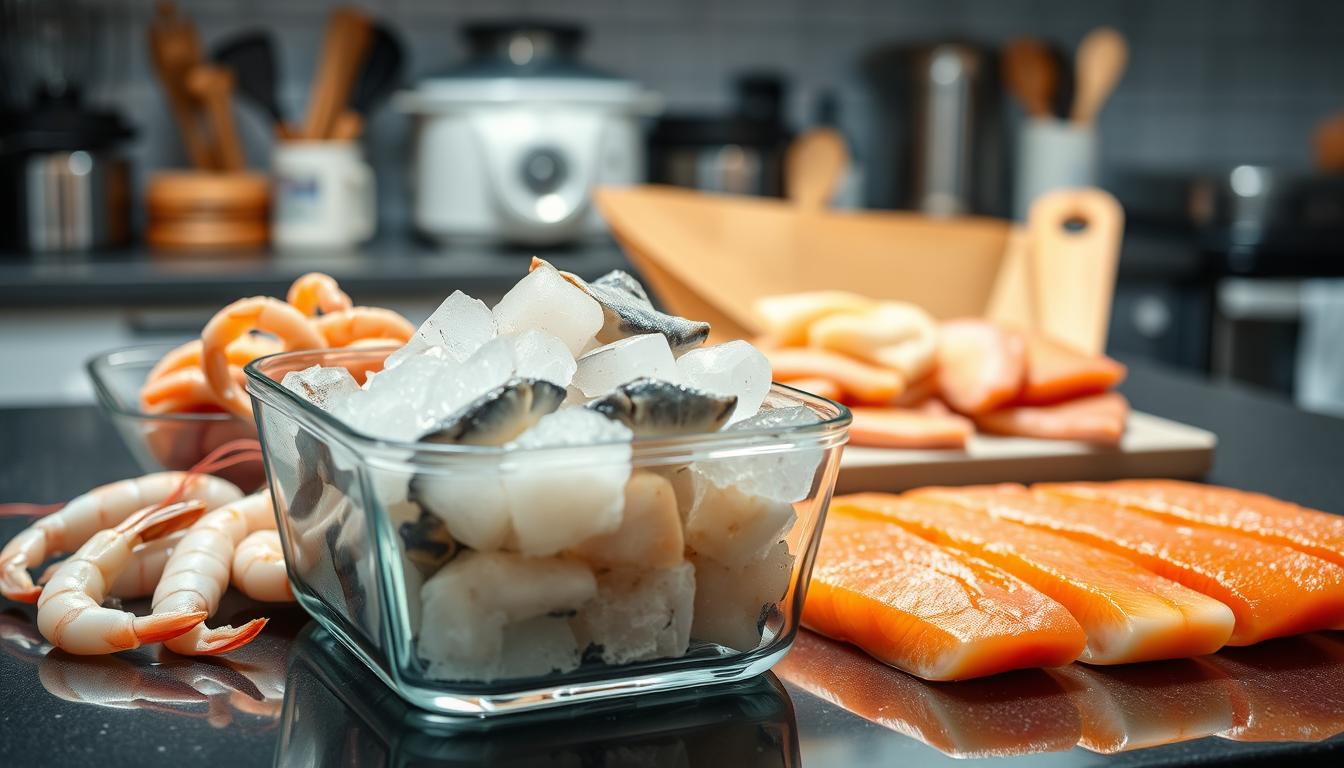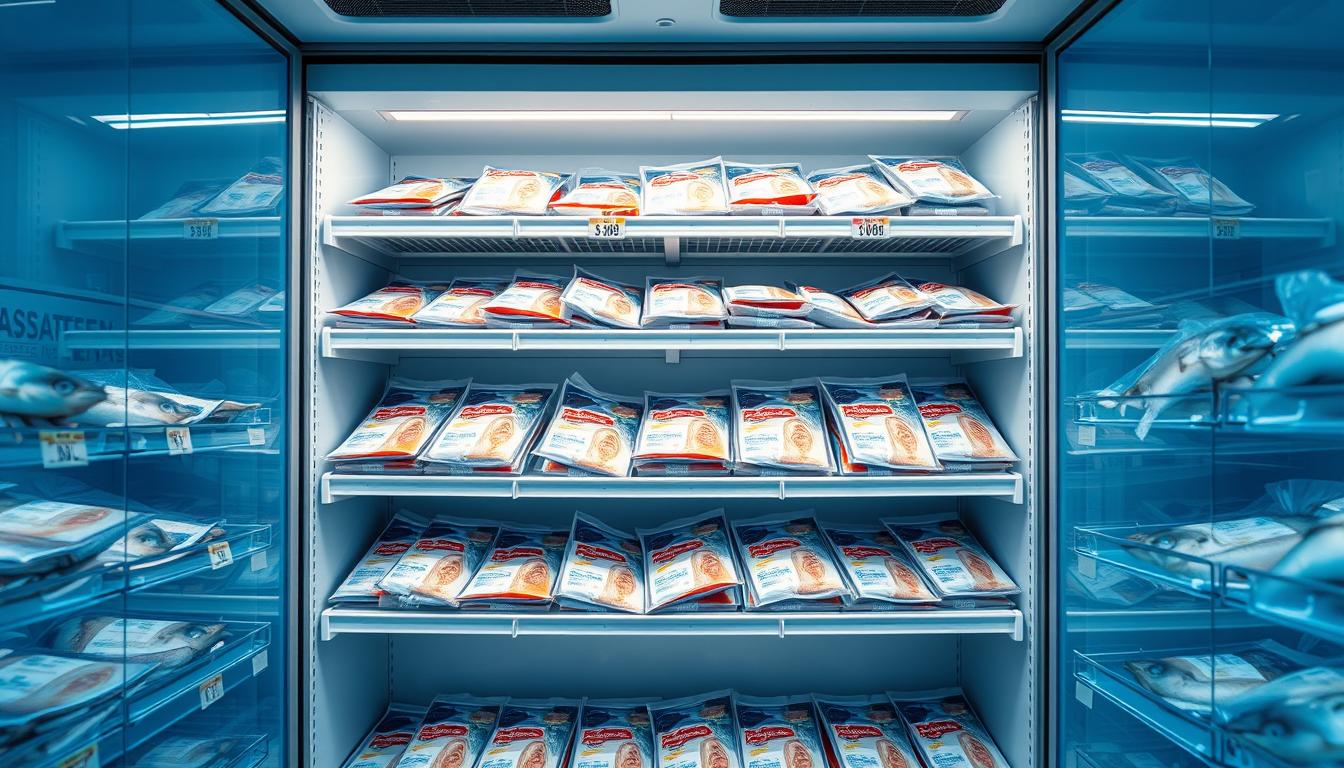Ever thought about refreezing seafood after it’s thawed? Many people wonder if it’s safe to do so. Freezing helps keep food fresh, but refreezing can lead to bacteria growth and changes in texture. This article will explore if refreezing seafood is safe and how to do it right to keep your food fresh and healthy.

Key Takeaways
- Refreezing seafood requires strict temperature control to avoid safety risks.
- Not all seafood types respond the same way to refreezing.
- Proper thawing methods prevent harmful bacteria growth.
- Quality changes like texture loss can occur during refreezing.
- Knowing when to refreeze ensures food safety and taste.
Understanding Seafood Freezing: What You Need to Know
Freezing seafood right is essential for keeping it safe and fresh. Knowing how to freeze and refreeze seafood properly is important. It helps keep the taste, texture, and safety of the seafood intact. This section will guide you on how to avoid common mistakes.
Importance of Proper Freezing Techniques
- Use airtight containers or vacuum-sealed bags to block air exposure.
- Set freezer temperatures at 0°F (-18°C) to pause bacterial growth.
- Label packages with dates to track storage duration and avoid extended stays.
How Freezing Affects Seafood Quality
- Ice crystals form during freezing, breaking down cell walls and altering texture.
- Flavors can weaken if stored too long, even when frozen properly.
- Refreezing seafood after thawing risks introducing harmful bacteria if not handled right.
Can You Refreeze Seafood? An Overview
When deciding whether to refreeze fish, balance convenience with safety. Some seafood can be safely refrozen, but it changes quality and safety. Here’s what matters most:
- Fish type: Firm-textured species like salmon or cod handle refreezing better than delicate varieties like sole.
- Thawing method: Seafood thawed in the fridge retains more moisture and texture than microwave or room-temperature methods.
- Time limits: Never refreeze fish left out for over two hours (one hour if above 90°F).
Refrozen fish may lose crispness or moisture but remains safe if stored correctly. Thawed seafood should be cooked within 24 hours if not refrozen. Always check for off smells or slimy textures before refreezing—these signal spoilage.
Pro tip: Portion fish into single-use servings before initial freezing. This reduces the need for refreezing and minimizes quality loss. Always label packages with dates to track storage time.
Safety Guidelines for Refreezing Seafood
Following guidelines for refreezing seafood is key to avoid harmful bacteria and keep food fresh. Here are the steps to ensure your seafood stays safe and tasty.
Temperature Considerations
To keep seafood safe while thawing, remember:
- Store it in the fridge at 40°F (4°C) or lower.
- Thaw in cold water (change water every 30 minutes) or use the microwave.
- Never let it sit at room temperature—bacteria grow fast above 40°F.
Time Limits for Safe Refreezing
Time is important to prevent spoilage:
- Thaw seafood in the fridge within 1–2 days before freezing again.
- Throw it away if it’s been at room temperature for over 2 hours (1 hour if it’s really hot).
- Freeze it right away after thawing in cold water or the microwave.
| Factor | Safe Guideline | Risk if Ignored |
|---|---|---|
| Thawing Environment | Refrigerator or controlled thaw | Bacterial growth |
| Storage Time | 1–2 days max in fridge | Pathogen proliferation |
| Refreezing Window | Within 24 hours of thawing | Texture and safety loss |
Refreezing Different Types of Seafood
Not all seafood freezes the same way. Shrimp, fish, and shellfish need different methods to stay good. Knowing these differences helps you keep your seafood fresh and tasty.
Fish, Shrimp, and Shellfish Differences
| Type | Best Practices | Texture Impact | Key Tips |
|---|---|---|---|
| Fish | Freeze solidly in single layers | Becomes flaky if thawed too long | Use airtight containers |
| Shrimp | Freeze quickly on a tray before bagging | Maintains firmness if done correctly | Use moisture-proof packaging |
| Shellfish (clams, crab) | Only refreeze raw varieties | Risk of sogginess after thawing | Discard if shells are cracked |
Refreezing Cooked vs. Raw Seafood
- Cooked seafood: Refreeze within 3 days of cooking. Texture softens slightly but remains safe.
- Raw seafood: Refreeze immediately after thawing. Retains original texture best when handled properly.
When refreezing shrimp, always check for odors or discoloration before reprocessing. Cooked shrimp should be chilled rapidly before freezing to prevent bacterial growth.
Steps to Safely Refreeze Your Seafood at Home
Refreezing shellfish needs careful steps to keep it safe and fresh. Follow these guidelines to avoid quality loss and foodborne risks:
Proper Thawing Techniques
- Always thaw shellfish in the refrigerator. Place it in a shallow dish on the bottom shelf to prevent drips.
- Never thaw at room temperature. This creates a breeding ground for bacteria.
- Use thawed seafood within 24 hours or proceed to refreeze immediately after thawing.
The Refreezing Process Simplified
After thawing, prepare seafood for storage:
- Portion control: Divide into single-serve amounts to avoid repeated thawing.
- Wrap securely: Use moisture-proof wrap or vacuum-sealed bags to block air exposure.
- Label clearly: Note the date and type of seafood. Discard if frozen longer than 3 months.
Check for any signs of spoilage before refreezing. Smell, texture, or color changes mean it’s unsafe to refreeze.
Minimizing Waste with Effective Seafood Storage
Proper storage is key to keeping seafood safe and reducing waste. By using smart strategies, you can make your seafood last longer. This helps avoid throwing away good food. Here’s how to keep your seafood fresh and sustainable:

First, pack seafood tightly to stop air from getting in. Air causes freezer burn. Use airtight containers or heavy-duty freezer bags. Also, label each package with the date to keep track of freshness. Here are quick steps to remember:
- Portion seafood before freezing to use only what you need.
- Wrap in moisture-proof wrap before sealing in containers.
- Keep your freezer at 0°F (-18°C) or colder to maintain safety.
A well-organized freezer helps you keep track of items. It ensures nothing gets forgotten. Below are storage guidelines for common seafood types:
| Seafood Type | Storage Method | Max Recommended Time |
|---|---|---|
| Fish fillets | Vacuum-sealed bags | 3-6 months |
| Shrimp | Airtight containers with ice glaze | 4-6 months |
| Shellfish | Freezer-safe ziplock bags | 2-3 months |
Regularly check for ice crystal buildup. It’s a sign of temperature changes that risk safety of refreezing seafood. By following these tips, you protect your investment and your family’s health. Small changes in storage can make a big difference in reducing waste and keeping quality high.
Handling and Cooking Seafood After Refreezing
After refreezing fish fillets, it’s important to prepare them right. This ensures they are safe and delicious. Follow these steps to avoid risks and keep quality high.
Reheating needs careful methods to stop bacteria from growing. Here’s how to do it right:
Best Practices for Reheating
- Heat thoroughly to 165°F. Use an oven or steamer for even heat.
- Avoid microwaving whole fillets—cut into smaller pieces for even cooking.
- Discard any leftovers not eaten within two hours of reheating.
Safety Tips for Cooked Seafood
- Use a food thermometer to confirm internal temperature.
- Never leave reheated seafood at room temperature longer than two hours.
- Add fresh ingredients like lemon or herbs after reheating to boost flavor.
Overheating dries out fish, so monitor closely. Once reheated, eat it quickly to keep texture and safety.
Common Myths About Refreezing Seafood Debunked
Myths about refreezing seafood can confuse even experienced cooks. Let’s clarify the facts to help you make safe choices.
- Myth 1: “You can never refreeze seafood.”
- False. Properly thawed seafood can be refrozen if handled correctly. The key is to thaw it in the fridge and refreeze quickly.
- Myth 2: “Refreezing cooked seafood causes harmful bacteria growth.”
- Risk depends on storage. When you refreeze cooked seafood within two days of thawing, bacteria growth is minimal if kept at 40°F or below.
- Myth 3: “Texture loss is unavoidable when refreezing.”
- While some texture change occurs, sealing seafood in airtight containers slows ice crystal formation. This preserves quality better than leaving it exposed.
Experts agree: refreeze cooked seafood only if it was thawed safely. Avoid leaving seafood at room temperature for more than two hours. Always check for off smells or slimy textures before refreezing, as these signal spoilage.
Remember, proper techniques turn myths into manageable steps. Follow guidelines, and you’ll keep meals safe without sacrificing taste or safety.
Understanding the Impact on Seafood Quality
Freezing and then thawing seafood can change its texture, taste, and nutrients. These changes depend on how many times you freeze and thaw it. Knowing these effects helps you keep your seafood fresh longer.
Texture and Taste Changes
Freezing and thawing seafood can alter its texture and taste. Here are some common changes:
- Texture: Fish fillets may become soggy or fibrous. Shrimp might lose their springy texture.
- Flavor: Over-refreezing can weaken natural sweetness. Some seafood develops a metallic or fishy aftertaste.
- Aroma: Prolonged storage may cause off-odors, even if the seafood remains safe to eat.
Nutritional Considerations
Nutrient loss occurs gradually with each freeze-thaw cycle. Key points to consider:
- Omega-3s: Fatty acids like EPA and DHA stay mostly intact but may drop by 5-10% with repeated freezing.
- Vitamins: Water-soluble B vitamins (like B12) decline faster when thawed at room temperature.
- Proteins: Protein content remains stable, but texture changes can affect how your body digests it.
Expert Advice on Refreezing Fish and Other Seafood
Professional chefs and food safety experts have shared ways to safely refreeze seafood. They show how to keep your meals safe by following both industry practices and home cooking rules.
Industry Standards
The USDA sets strict rules for commercial refreezing. Here are some key points:
- Maintain freezers at 0°F (-18°C) or colder to halt bacteria growth.
- Use vacuum-sealed packaging to block oxygen and prevent freezer burn.
- Track thaw-refreeze cycles using digital thermometers for accuracy.
Guidelines for Home Chefs
Follow these steps to match professional standards at home:
- Thaw seafood in the refrigerator, not at room temperature.
- Divide into small portions before freezing to ensure even cold distribution.
- Label containers with thaw dates and freeze within 24 hours.
Professional kitchens also recommend checking for signs of spoilage like slimy texture or off smells before refreezing. By following these steps, you reduce risks and preserve seafood quality.
Conclusion
Refreezing seafood safely requires strict guidelines. Always check the initial freezing date. Don’t leave thawed seafood at room temperature for too long.
Use airtight packaging and quick refreezing to keep quality high. The FDA and USDA say to keep seafood below 40°F during thawing. This stops bacteria from growing.
Freezing can change the texture and taste of seafood. But, using the right methods can lessen these changes. Vacuum-sealed containers are best for fish or shrimp to keep air out.
Cooked seafood must be reheated to 165°F to be safe. Use refrozen seafood within 3 months for the best taste.
Following these steps helps reduce waste and keeps seafood safe. Remember, refreezing is only safe if seafood was thawed right. Check expiration dates and watch for signs of spoilage.
Proper handling makes refreezing a smart choice for meal planning. It’s all about keeping seafood fresh and safe.
FAQ
Can you refreeze seafood after it has been thawed?
Yes, you can refreeze thawed seafood, but do it right. If thawed in the fridge and not warm, it’s safe to refreeze. But, thawing in warm water or at room temperature should be avoided.
What are the safety guidelines for refreezing seafood?
To safely refreeze seafood, keep it cold (below 40°F) while thawing. Refreeze it within a couple of days if stored in the fridge. Always check for off smells or texture changes before freezing again.
Is it safe to refreeze cooked seafood?
Yes, cooked seafood can be safely refrozen. Just make sure it’s cooled down first and not left out too long. Store it in airtight containers to keep quality high.
What should you know about refreezing fish fillets?
When freezing fish fillets, thaw them in the fridge, not at room temperature. Freezing can change texture and taste. Use vacuum sealing or airtight packaging for better results.
Are there different rules for refreezing shrimp and shellfish?
Yes, shrimp and shellfish have their own rules. If thawed safely in the fridge, they can be refrozen. But, cooked ones left out too long should not be refrozen for safety.
How can you minimize the impact on seafood quality when refreezing?
To keep seafood quality high when refreezing, wrap it tightly in plastic or use vacuum-sealed bags. Label packages with dates. Refreeze seafood as soon as possible after thawing.
Can refreezing seafood affect its nutritional value?
Refreezing seafood might change its texture and taste, but it usually doesn’t hurt its nutritional value. Yet, each freeze-thaw cycle can slightly reduce quality. So, try to freeze and thaw seafood as few times as possible.
